Walmgate Bar stands as a remarkable testament to York’s rich medieval heritage, serving as one of the city’s four principal gateways and the most complete among them. Situated on the southeastern stretch of the York City Walls, Walmgate Bar is distinguished by its preservation of key defensive features, including a barbican, portcullis, and inner doors—elements that have vanished from the city’s other bars. This unique combination of architectural features makes Walmgate Bar not only a significant historical monument but also a vivid window into the city’s past.Kristie Dean+8Medieval Histories+8Yorkshire Guides+8Wikipedia+7GPSmyCity+7History of York+7
Historical Background
The origins of Walmgate Bar trace back to the 12th century, with the earliest surviving masonry being the inner arch of the main gate. The name “Walmgate” is believed to derive from “Walba’s gate,” referencing an individual from the Anglo-Scandinavian period. Initially, this gate served as a simple passage through the city’s defenses, but over time, it evolved into a more complex structure. By the 14th century, significant enhancements were made, including the addition of the barbican—a fortified outpost or gateway—which remains intact today, making Walmgate Bar the only bar in York to retain this feature. The wooden gates, dating from the 15th century, and the timber-framed building on the inner side, added in the 16th century, further contribute to the bar’s historical significance. Wikipedia+4her.york.gov.uk+4Britain Express+4Wikipedia+1Wikipedia+1History of York+1citymakinghistory.org+1
Architectural Features
Walmgate Bar’s architecture reflects the defensive needs and aesthetic sensibilities of medieval York. The gatehouse comprises a passageway with arches at each end and a rectangular structure above, featuring two stories. Bartizans—small overhanging turrets—are located at the angles facing Lawrence Street, providing vantage points for defenders. The rear of the gatehouse boasts a timber-framed projection supported by two stone columns, showcasing the blend of stone and timber construction techniques prevalent during the period. The barbican, a walled extension in front of the gate, served as an additional line of defense, allowing defenders to trap and attack invaders caught between the outer and inner gates. The presence of the original portcullis and inner wooden doors further underscores the bar’s defensive capabilities. her.york.gov.uk+1Wikipedia+1
Role in Historical Events
Throughout its history, Walmgate Bar has played a pivotal role in York’s defense. During the English Civil War, the bar was a focal point in the 1644 Siege of York. Parliamentarian forces targeted Walmgate Bar, setting up artillery on Lamel Hill to bombard the gate. They also attempted to undermine the barbican by digging a mine beneath it; however, Royalist defenders successfully countered this by flooding the mine through a countermine. The scars from the cannon fire are still visible on the bar today, serving as tangible reminders of the conflict. pamelahartshorne.com+1www.york-united-kingdom.co.uk+1WikipediaWikipedia
Civic and Social Functions
Beyond its military significance, Walmgate Bar also served civic and social functions. In the medieval period, it acted as a toll gate, regulating and taxing goods entering the city. Records from 1280 mention tolls collected at the bar, and by 1376, there is documentation of rent being paid for the dwelling above the gate. The timber-framed building atop the gatehouse was used as a residence until 1957, highlighting the bar’s integration into the daily life of the city. Wikipedia+2www.york-united-kingdom.co.uk+2her.york.gov.uk+2
Preservation and Restoration
Over the centuries, Walmgate Bar has undergone various restoration efforts to preserve its structure. Significant repairs were carried out between 1645 and 1648 following damage sustained during the Civil War. Further restoration occurred in the 19th century, and in 1959, additional renovations were undertaken to maintain the bar’s integrity. In recent years, the City of York Council, in collaboration with English Heritage, has invested over £100,000 to protect and preserve Walmgate Bar, ensuring that this historical monument continues to be a part of York’s heritage. Wikipedia+2her.york.gov.uk+2Jorvik.co.uk+2Medieval Histories
Visiting Walmgate Bar Today
Today, Walmgate Bar is accessible to visitors and forms part of the York City Walls walk—a popular route that offers panoramic views of the city and insights into its medieval defenses. Visitors can explore the barbican, pass through the gatehouse, and ascend to the walls, experiencing firsthand the architectural features that have stood the test of time. Interpretation panels along the route provide historical context, enriching the experience for those interested in York’s past. Medieval Histories+15www.york-united-kingdom.co.uk+15Yorkshire Guides+15Wikipedia+2Alan Dotchin’s Blog+2Wikipedia+2
Conclusion
Walmgate Bar stands as a remarkable testament to York’s rich medieval heritage, serving as one of the city’s four principal gateways and the most complete among them. Its preservation of key defensive features, including a barbican, portcullis, and inner doors, offers a unique glimpse into the city’s past. From its role in historical conflicts to its integration into civic life, Walmgate Bar encapsulates the multifaceted history of York. Ongoing preservation efforts ensure that this iconic structure will continue to educate and inspire future generations.

